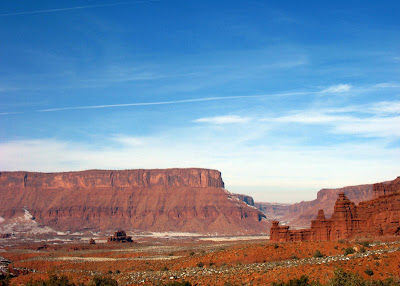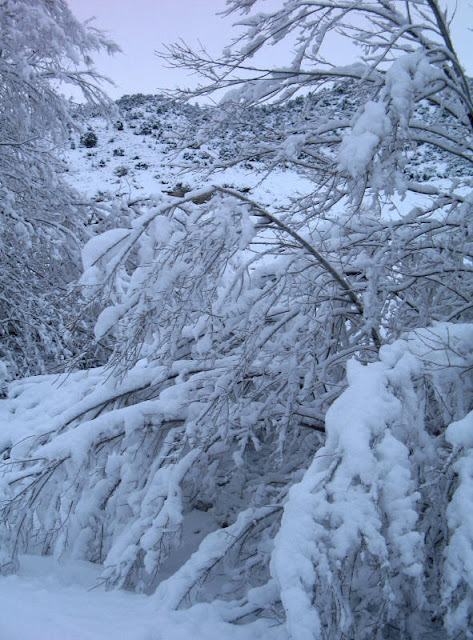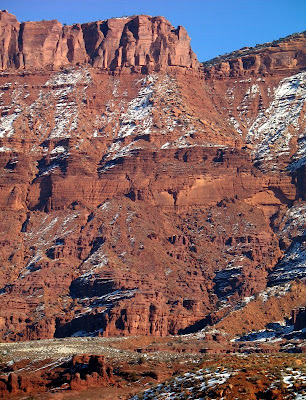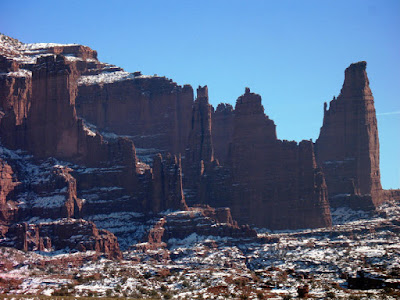So, what is the difference, do you think, between a mining geologist and an exploration geologist?
This is a post partly in response to Phizzle Dizzle's question:
WTF do you do?When I was getting my first degree in geology, I figured I'd go into something I called "Economic Geology" because that's what the courses at
VPI&SU were called, and because I liked looking at polished shiny metals under an ore microscope, and also because ore deposits or mines or mining areas are often great places to collect mineral samples, which I was really into at the time. Because my knowledge of economic geology was limited, I ended up in the mining hub of Reno, Nevada, without knowing that it was a mining hub.
Reno is a mining hub - it is and has been one for a long time for three basic reasons: 1) gold and silver were
discovered on the Comstock Lode - at Virginia City, Gold Hill, Silver City, and Dayton - in the Virginia Range not too far southeast of Reno (gold as early as 1850; silver in
1857 or
1859), 2) because
John William Mackay (rhymes with wacky) was involved in the Comstock lode, made a name for himself and perhaps a little bit of money, and had a mining school named after him in the town of Reno: the
Mackay School of Mines, now known as the
MSESE not the MSM (
John Mackay's statue here), and 3) because a whole bunch of mining and exploration companies have or have had offices there. When I moved to Reno, I knew only that there was a thing called the Mackay School of Mines at
UNR, and I didn't know a whole lot more than that.
Mining and exploration companies are entities that either mine or conduct exploration for commodities to mine. Those commodities can be things like sand, gravel, and limestone, or they can be things like gold, copper, or silver. Sometimes mining and exploration companies both mine and explore, but not always. Hence the name, for example, Noranda Exploration Inc. (USA), which conducted exploration and some mining in the U.S. in the 1970's and 1980's (and possibly before that), and the name
Noranda Mines Ltd., which mined in Canada ever since its formation in 1922 and conducted some exploration. [The described history of Noranda Mines Ltd., later known as Noranda Inc., is good only through 2004, after which time it merged with
Falconbridge, after which Falconbridge succumbed to a hostile takeover by
Xstrata; Falconbridge's website, archived by Xstrata, is less than 100% functional, and you may have to click java error messages several times to read it.]
One reason I bring these things up is that nowadays if you work at a mine, it doesn't matter what you do, you are a miner. A secretary working at a mine is a miner. A miner working at a mine is a miner. A carpenter working at a mine is a miner. A truck driver working at a mine is a miner. An accountant working at a mine is a miner. Part of that determination or terminology has to do with
MSHA and the rights of miners. Under MSHA regulations, anyone working at a mine is defined as a miner and has
miners' rights (see page 10). Another reason I bring this up is because I personally know few geologists who consider themselves to be mining geologists: most of my colleagues consider themselves to be exploration geologists.
What is an exploration geologist? The first time I heard of an exploration geologist was my second year in grad school, when I was sharing a grad school office with a guy who was T.A.ing Optical Mineralogy and Petrography with me, with me essentially in the lead because it was my second year at it and his first. He kept saying things like, "I want to be an explorationist" or "I want to be an exploration geologist." He also wanted to get married and have kids. At that time, during my second year in grad school, I was taking a course called Exploration Geology. Happened that it was taught by an erstwhile professor: a consulting geologist who consulted for the mining industry, usually by conducting mineral exploration. Happened also that at least one of "the boys from downtown," as he sometimes called them, was taking the course. They were exploration geologists, although I knew them only as "the boys."
An exploration geologist is someone who explores for a commodity to mine. You explore for, try to find, sniff out, look for, poke around, and try to "find a mine" - as one of my colleagues used to say. He would especially say that when our company finally got around to having yearly performance appraisals partly based on goals we would set every year, with each goal having its own action plan, and each action plan having its own timeline. He would persistently insist that our only real goal was to "find a mine," and that's all he'd put down on his list. He wasn't into paperwork or bureaucracy very much.
So, is this a coherent post? Maybe not. It may be more of a ramble, and it has partly been precipitated - like a bunch of little calcium carbonate crystals falling out of seawater - by miscellaneous stuff, including stuff at work, not recent stuff, but stuff nonetheless [i.e., I ain't sayin'].
So, where to now from here? How about this: what are core loggers? Core loggers are geologists who log core - at mines and at exploration sites, near large or small mining towns or way, way, way out in the sticks. [Elko, NV, qualifies as a large mining town, with a population of about 16,000 to 20,000 depending on what website you read.]
Drill core consists of long, tubular rocks that come out of the ground during core drilling, as compared to drill cuttings, little chips of rocks that come out of the ground during rotary drilling. Core comes in core boxes, either wooden and heavy as hell or cardboard and only almost heavy as hell (well, especially if you've been drilling
massive sulfides or
magnetite skarns).
Chips come in
plastic trays, these days, and it's easy to carry about 800 to 1200 feet of drilling at once, depending on the awkwardness of the trays all trying to fall out of your arms.
Are people who log core or chips at mines or exploration sites, like some of my colleagues and like me, mining geologists or exploration geologists? [We'll just call them all core loggers, to make it simple, although most everyone who logs core or chips does way more than just log.] I guess that's a tough question, and it probably depends on each geologist's background.
Most of the geos I know, who are working in the mining and exploration business, think of themselves as geologists first or second and exploration geologists second or first (depending). Some of these geos have almost exclusively conducted exploration in the past, spending all their waking or working hours looking for something economic to mine. A few of these geos have worked at mines as mine geologists, in surface and in underground mines. Even while working at a mine, many core-logging geos are conducting exploration - sometimes even the mine geologist conducts exploration, sometimes he/she doesn't. [An aside: I don't know any women working as mine geologists, or any who ever have.] That is to say, our main job while working at the mine or on a mining property is to explore for and find more ore. Find! More!! Ore!!!
What I mean is, we are finding, exploring for, looking for, beating the bushes if there are any, looking high and low, rummaging around, digging here and there, drilling holes all over the place if they've given us enough money to do so - we are exploration geologists.
Now, that's not to say that I haven't met any core loggers at or near mines that I wouldn't consider something besides exploration geologists. I think, though, that this geo-type classification depends on background and on outlook of the individual geologist. Some geos at mines just don't have an exploration outlook. They are not thinking about where the next bit of ore might be found. They are not trying to find more ore; instead, they are primarily concerned with dealing with the ore that has already been found. [A few that I've met - very few - appear to be thinking about almost nothing.]
One definition of a
mining geologist:
...the role of the mining geologist is to always keep the resource inventory to an optimum level for the mining business and to maximise the transformation of the resources into reserves in a multi-disciplinary work environment. In short, a 'good mining geologist has to always provide the best ore to the mill'. [italics not mine.]
A page at
Impala Platinum Holdings Limited explains the difference between mining geologists and exploration geologists as follows:
Geologists operate in wide areas. Two of these, mining geology and exploration geology, are vital to the mining industry.
- Mining geologists ensure that the minerals are efficiently extracted from the deposit for maximum profit.
- Exploration geologists locate deposits of important minerals and determine whether the quantities are large enough to make mining economically viable.
Most of the geologists employed by Impala are mining geologists although there are a number of exploration geologists. Mining and exploration geologists have different responsibilities and are involved in different job activities.
They go on to further define
mining geology, without further defining exploration geology:
A mining geologist's activities include mapping, recording and compiling geological data in and around the mine. This provides the mining engineer with details of the location, structure and distribution of ore in a deposit. Furthermore, the mining geologist delineates the ore reserves on which the mine's life depends, using geoscientific techniques to predict the grade and structure of ore bodies in unknown areas. The mine geologist plays a crucial role in the optimisation of the ore body and is intimately involved in the mine planning process.
Ah, but in that last part, they ran
mining geologist and
the mine geologist together in the same description!
I could possibly rephrase that last definition for an exploration geologist, at least for an exploration geologist working at or near a mine:
A exploration geologist's activities include mapping, recording and compiling geological data in and around the mine, often conducting exploration for more ore outside the mine area. This provides the exploration manager and the mine geologist with details of the location, structure and distribution of ore in and around the ore deposit. Furthermore, the exploration geologist sometimes is called upon to delineate and characterize the ore reserves on which the mine's life depends, using geoscientific [yikes! what a word!] techniques to predict the grade and structure of ore bodies in known and unknown areas. The exploration geologist often plays a crucial role in the optimization of the ore body and can be intimately involved in the mine planning process.
Okay, that's deep enough!
More Mackay info:New York Times 1912 on the Mackay family's gifts to Univ. NV and the
original articleJohn W. Mackay biography at Answers.comWM Keck Earth Science and Mineral Engineering Museum with
original dedication documents of the MSM buildingHistory of the Mackay Mansion
 A classic movie to look for is "Search for the Mother Lode: The Last Great Treasure," in which Charleton Heston gets to play two brothers, one of which is a crazed and crazy gold prospector.
A classic movie to look for is "Search for the Mother Lode: The Last Great Treasure," in which Charleton Heston gets to play two brothers, one of which is a crazed and crazy gold prospector.













































